
Sage Kiernan-Sherrow | News Editor
“Our dead are never dead until we have forgotten them,” said Western’s Multicultural Student Union Representative, Paola Sumoza, during the Dia de los Muertos celebration on Oct. 30. The MSU hosts a Dia de los Muertos celebration every year; the event is free and anyone is welcome to attend and learn more about this important historical holiday.
Dia de los Muertos, or Day of the Dead, is an ancient holiday with its roots in Aztec culture. Later, it fused with Catholic beliefs when the Spanish conquistadores began colonizing the Americas. Today, Dia de los Muertos is a two-day celebration strongly celebrated in Mexico, and in some Latin American countries as well. It is celebrated on the first and second day of November; the first day is dedicated to the children who have died and is known as Dia de los Angelitos.
With a focus on honoring ancestors and loved ones, Dia de los Muertos invites the dead to come to the land of the living to reconnect with their families. Traditionally, the families of the dead set up altars — much like the one displayed in the Werner University Center paying homage to culturally-impactful deceased Hispanic and Latinx figures. The altars are decorated with ofrendas, or offerings, which provide ancestors with a safe passage back home. Most ofrendas carry symbolic meaning; while photographs of deceased loved ones are displayed, so too is water for the dead who are thirsty after their long journey and salt for purification.

An important figure representative of Dia de los Muertos is La Catrina, or the goddess of the dead. Donned in a feathered hat typical of the bourgeoisie, La Catrina was originally a political cartoon created by Jose Guadalupe Posada in the early 1900s to symbolize that death comes for everyone — even the aristocracy.
Dia de los Muertos was also represented in the 2017 Disney movie “Coco,” a film that gave representation to many people. During Western’s Dia de los Muertos festivities, Sumoza touched on this importance, saying, “now that I have my children, I’m teaching them these traditions and customs that we have and when we first watched “Coco,” something interesting that my daughter said was ‘Look mom, “Coco” celebrates it like we celebrate it.’”
At Western’s Dia de los Muertos celebration, students were invited to participate in cultural festivities, such as consuming pan de muerto, watching traditional dances which featured performances by Ballet Folklorico Tlanese, and getting their faces painted in traditional calavera — or sugar skull — design. It was a bright and colorful approach to processing death and grief, and respecting the ancestors that came before.
Contact the author at howlnews@wou.edu
Photos by Sage Kiernan-Sherrow

